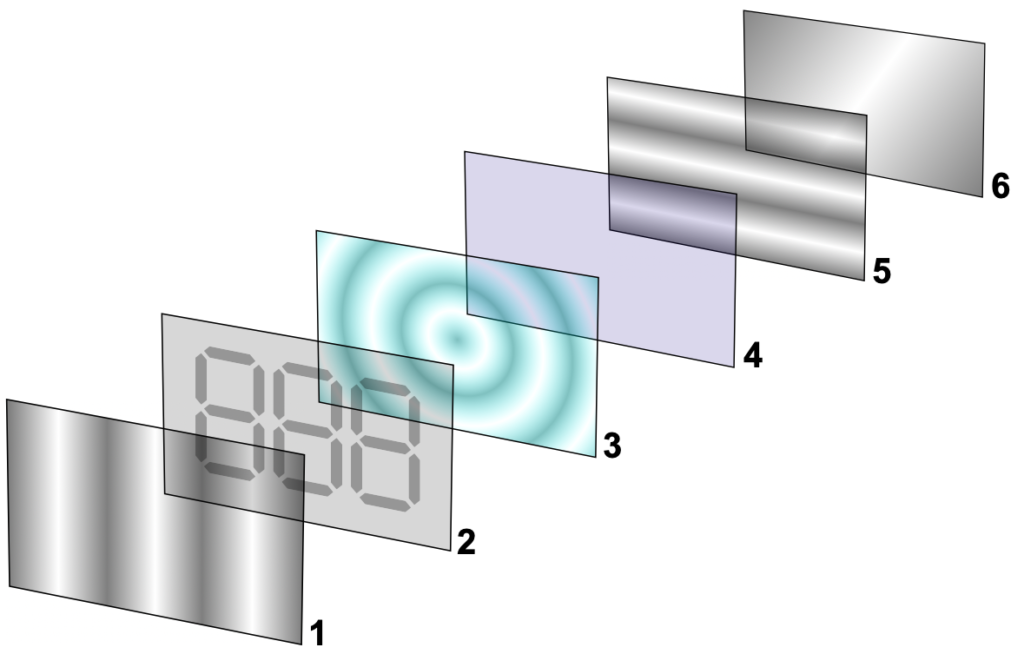One of my recent projects was an article on the display technologies used in mobile phones, laptops, TVs, etc. As is often the case, I learnt a lot from researching the piece. Which was useful as I was thinking it is about time to buy a new TV.
One thing I was not previously aware of was the way terminology is used in marketing TVs. There are LCD TVs and various types of LED TVs, including the futuristic-sounding Quantum-dot LED (QLED) and OLED TVs.
It turns out that nearly all of these are LCD TVs. In most cases, the “LED” in the name just refers to the source of the light for the display. There is one important exception, which we will come to later.
First, it may be worth providing a bit of background, for those not familiar with how these display technologies work.
Liquid Crystal Display (LCD)
A liquid crystal is a chemical compound that has a regular molecular structure like a crystal but remains fluid. These compounds have a number of interesting properties. One is that the molecular structure can be modified (twisted) by applying a voltage across the liquid crystal. This twisting changes the way polarised light is affected as it passes through the liquid crystal.
This effect can be used to create displays by putting a liquid crystal layer between two electrodes and two polarising filters. (The electrodes are sufficiently thin that they are transparent.)

Source: https://commons.wikimedia.org/wiki/File:LCD_layers.svg
When no voltage is applied across the electrodes, the polarisation of light is rotated by 90° as it passes through the liquid crystal. Because the two polarising filters are at right angles to one another, the light passes through. When a voltage is applied across the liquid crystal, the angle of polarisation is rotated and the light cannot pass through the display.
One great advantage of LCD displays is that they consume almost no power: the electrodes are simply applying a voltage across the liquid crystal layer and so no current flows.
The first liquid crystal displays had fixed areas that could be turned on and off; for example the seven-segment displays used in calculators and similar devices. These often use reflected light (which is why they can be hard to see under some conditions).
As technology advanced it was possible to have a matrix of connections across the LCD allowing individual (but quite large) pixels to be turned on and off. This enabled low-resolution graphical displays.

Thin Film Transistor (TFT) Displays
The next step was the development of TFT technology, which puts an array of transistors across the display surface allowing large numbers of individual pixels to be controlled. This made it possible to use LCDs in high resolution computer and TV screens.
Colour displays can be made by adding red, green and blue colour filters for each pixel.
The brightness of the display can be improved by adding a light source behind the display. This increases the power consumption but for advanced displays this is a necessary addition.
The first displays used electroluminescent panels or fluorescent lamps to provide the backlight. These provide an even illumination across the whole display. However, because the LCD display cannot block light completely, it means that the “black” areas of the display are not completely dark because light leaks through.
More recent displays used LED lighting. These are used in LED TVs.
Light Emitting Diode (LED) Displays
LEDs provide a very efficient source of light. After the blue LED was commercialised in the 1990s, it became possible to use LEDs to generate white light.
Using LEDs for backlighting makes displays thinner and lighter. They also consume less power than fluorescent tubes. An array of LEDs can be used behind the display to provide even illumination. This has a secondary advantage that the brightness of the backlight can be adjusted across the screen. This allows the level of backlighting to be reduced in areas where the image is dark. This improves the contrast ratio of the display and makes the black areas of the image appear darker.
Samsung produces what they call Quantum-dot LED (QLED) displays. These use a layer of nanoscale crystals of semiconducting materials (“quantum dots”) that convert the light from the LED backlight into pure red, green and blue light for each pixel. This improves the brightness and colour accuracy of the display. Other manufacturers use similar technology with different names.But it is still an LCD TV.
The “real” LED TV
The ideal display would use an array of LEDs to generate the image directly, without going through an LCD layer. This would reduce complexity and cost. It would also improve the display quality: LCDs can never turn fully off to give true black and always lose some of the light even when turned fully on.
Organic LED (OLED) technology enables true LED displays. OLEDs use organic molecules instead of traditional semiconductors to create the LEDs. By combining this with a TFT array to control each pixel, a self-illuminating display can be produced: each pixel consists of the light from an LED (or, more accurately, three LEDs for red, green and blue light). This gives a bright, high contrast display with deep blacks.
OLEDs have other advantages, such as the fact that they can be printed onto almost any substrate, making flexible displays possible for example.
Currently OLED displays are significantly more expensive than LCD/LED displays because of the manufacturing costs. But prices should come down over time.
The other main disadvantage with current OLEDs is the limited lifetime, currently expected to be about 5 years.
With OLED TVs still priced at well over €1,000 I think I will wait a bit longer before investing in an OLED TV.
